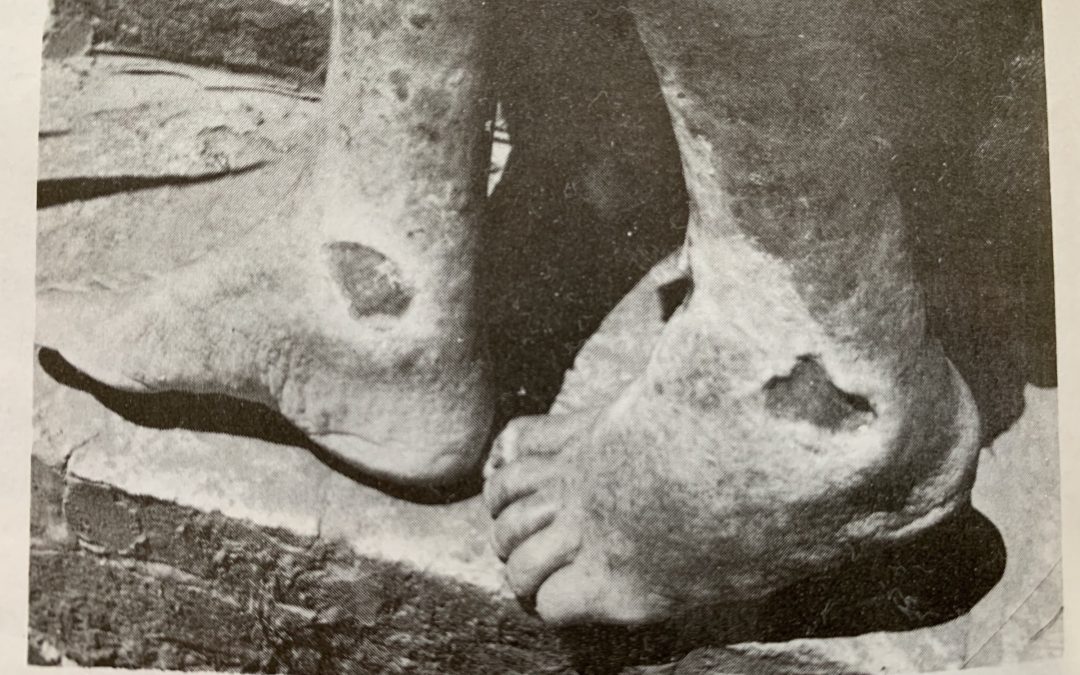The wounded feet of one of my father’s leprosy patients — circa 1950s
In a prior blog, I wrote about the importance of touch in my intimate relationship. When my partner and I discovered “the skin thing” over 20 years ago, we thought we were onto something new. It turns out, research has long had a lot to say about the benefits of touch.
When someone touches me with intention, like a pat on my shoulder or a hug (I’m talking platonic touch, not sexually-arousing touch), it awakens millions of super-sensitive pressure receptors in my skin. They send a signal via my neural pathways to my brain and adrenal glands, which then begin producing less of the stress hormone cortisol. This leads to all sorts of benefits, including reduced blood pressure and lower heart rate.
That same touch also stimulates my parasympathetic nervous system, which triggers an increase in my body’s production of serotonin, dopamine and oxytocin — all feel-good hormones that lower depression and anxiety, and also lead to boosting my immune system.
My skin — one of the largest organs of the body in surface area and weight — can do all of these wonderful things for me.
But only if I allow myself to be touched.
I was recently encouraged to reread Don Miguel Ruiz’s powerful little book The Four Agreements. He asks us to imagine that all humans, all of us, have wounds on our skin. None of us can touch one another because it hurts too much. And we don’t see our wounds as anything out of the ordinary because we all have them. The pain seems normal; the lack of touch seems normal.
Don Ruiz’s point is that each of us carries inside of us wounds infected with the poisons of fear.
My parents founded and ran a leprosy hospital in Paraguay, South America where I grew up, so I know more than most people about wounded skin.
Since leprosy affects the nerves, the disease often leads to ulcers and infection of the skin, and even paralysis and crippling of hands and feet (see photo at the top of this post). Leprosy patients are typically shunned and not touched even by their family and friends.
Someday I will blog about my experiences growing up on a leprosy compound. For now, I want to use wounded skin as an analogy of deeper wounds we all carry within us.
One of the wounds I carry is the fear of being too vulnerable and opening myself up in ways that allow others to hurt me. When I was young, I shared myself with others openly and freely. But as I matured, I found out that the world can be a very judgmental place. So I learned to protect myself by building walls around my heart, feeling the deep pain of not being known, but still not allowing myself to be touched.
As Don Ruiz said, given its pervasiveness, the pain seems normal. The lack of touch seems normal.
But it’s not.
My fear of vulnerability is ultimately a fear of rejection. It makes sense. I’ve been hurt before, so I want to minimize the risk of being hurt and rejected again. But building walls around my true self to create a space where I can hide is self-defeating. It leads to isolation and loneliness and ultimately often manifests as deep depression.
Instead, can I show up vulnerably, with all of my many imperfections, doubts, insecurities and past mistakes? Can I love and accept my whole, flawed and authentic self enough that I no longer cringe in fear of others’ judgments?
And if I do, are you willing to join me?


I received limited touching during my early life. I was probably in my 30s before I realized how important it was to my feelings. To build the authentic relationships where touching occurs naturally and appropriately does require confronting the risk of rejection. The closer I get to people the greater the risk of rejection as they come to know the deeper flawed pieces of me. With that risk comes the increased probability of authentic acceptance and the touching that frequently goes with it.
For me it is often worth the risk. What about you?
Thank you so much for sharing about this topic which means a lot to me.
Sometimes I ‘ve opened up but my ideas have been rejected . However I’d like to take baby steps towards taking down the walls that make us feel ilsolatd and lonely.
Lorna, thank you for sharing this. Since I know you outside of this blogging conversation, I can say that you are one of my most honest friends. And I treasure that about you!